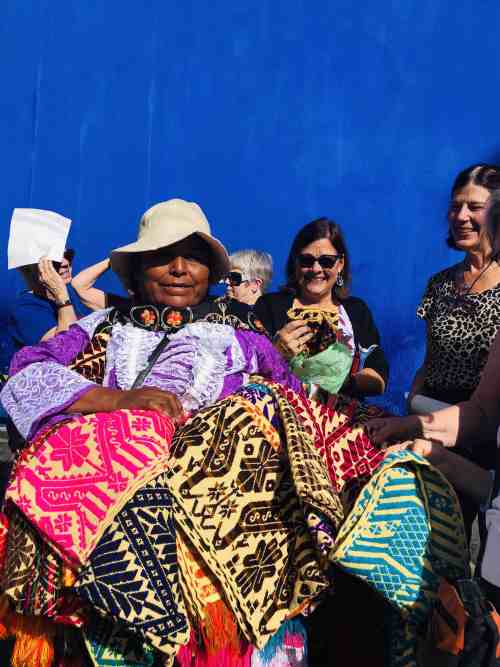Art history is a fascinating way to learn more about Mexico and the figures who shaped the nation — political, social, cultural. Through their interpretation of characters and events, the famed muralists — Diego Rivera, David Alfara Siqueiros, and Jose Clemente Orozco — gave definition to a new nation seeking to redefine itself post-1920 Revolution. We call this Mexican Muralism.


While I’m now in Teotitlan del Valle, Oaxaca, I’m reflecting back to last weekend in Mexico City, where, in collaboration with my art historian friend Valeria, we led a group of nine participants from the USA through the historic center. Here is where a turbulent history is interpreted through art. We started on Thursday evening and ended on Sunday afternoon, packing it in, walking miles each day, absorbing a fascinating evolution.


Mexico is defined by many internal and external forces, mostly her on-going desire to reconcile the Spanish conquest with her indigenous origins. Embracing Mestizaje — blending indigenous roots with conquerors, occupiers and immigrants, is what makes Mexico unique among nations, and very different from her northern neighbors.


Rivera, who sat out the 1910-1920 Revolution, painting and making a name for himself in Europe, returned to Mexico City in 1921. Jose Vasconcelos, the first minister of education, recruited Rivera to paint the murals at the Secretariat de Educacion Publica (SEP), his first commission.

The murals of Rivera, Orozco and Siquieros are commentaries on national identity, statehood, oppression and power. The Rivera murals at SEP in particular were part of a national communication plan (aka propaganda) to embrace native culture and arts. Critics say Rivera’s murals are romantic and idealistic. His contemporaries, survivors of the Revolution, painted a more hopeless, violent vision, expressing their belief that the past must be destroyed in order to create a new order.


By Sunday, we move more deeply into the life and times of Frida Kahlo with a visit to Casa Azul, a stark contrast to the muralists.

Frida Kahlo was born in 1907, the year Rivera went to Europe as a young man. During her lifetime she was dwarfed literally and figuratively by her imposing husband. It wasn’t until after her death in 1954 at age 47, that she became the iconic figure she is today — representing women’s strength, pain, fortitude, perseverance, endurance.

We revere her because her art is self-expression. She painted emotion and the internal life. She was a participant, not an observer. She hid her deformities under extraordinary handmade Mexican clothing — popularizing the style, corseted beneath to hold her injured spine erect. Andre Breton called her surrealist. We call her survivor.


Our art history tour weaves the relationship between Diego and Frida with the times in which they lived and worked. We also examine the politics of Socialism and Communism in Mexico, how the Rivera’s gave sanctuary to Leon Trotsky, the idealism of young American artists like Pablo O’Higgins, Isamu Noguchi, and the Greenwood sisters — Marion and Grace, who were drawn to the movement. We see their deteriorating murals in an obscure market blocks from the city center.



We understand Mexico more now, how the creative stream of artistic energy here continues to express social and political inequalities, injustices, and discontent.


Here in Oaxaca, our beloved Maestro Francisco Toledo, carried the mantle of social justice art until he died in September 2019. Young graphic artists follow in the footsteps of the masters, use wood, linoleum block and metal plates to carve out images of truth to power. Mexico offers creative opportunity to any and all who choose to express themselves.


Note: If you put together a group of 5-6 people, I am happy to organize this experience over a long weekend in Mexico City.



at Abelardo Rodriguez Market






